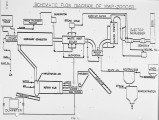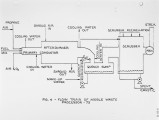| Title |
Incineration of Hazardous Waste in a Mobile System |
| Creator |
Acharya, Prakash, P.E. |
| Publisher |
University of Utah |
| Date |
1984 |
| Spatial Coverage |
presented at Tulsa, Oklahoma |
| Abstract |
The principal system described is the third generation of Pyrotech's hazardous waste processors. The system can burn a wide variety of solid and liquid wastes efficiently while meeting stringent emmision standards. Two mobile liquid incinerators were constructed prior to developing the solids handling capability. The first mobile waste processor (MWP-75) obtained an EPA permit to burn 60 gallons per hour of polychlorinated biphenyls (PCBs) up to 42 percent (by. wt.) concentration, in 1982. The second unit was scaled to process 100 gal./hr. of 77 percent (by. wt.) PCBs. The unit is scheduled to under go a trial burn in October, 1984. Although the first unit is permitted to burn only PCBs at this time, other liquid wastes with heating values above 4500 BTU./lb. can also be incinerated. |
| Type |
Text |
| Format |
application/pdf |
| Language |
eng |
| Rights |
This material may be protected by copyright. Permission required for use in any form. For further information please contact the American Flame Research Committee. |
| Conversion Specifications |
Original scanned with Canon EOS-1Ds Mark II, 16.7 megapixel digital camera and saved as 400 ppi uncompressed TIFF, 16 bit depth. |
| Scanning Technician |
Cliodhna Davis |
| ARK |
ark:/87278/s6542r43 |
| Setname |
uu_afrc |
| ID |
1800 |
| Reference URL |
https://collections.lib.utah.edu/ark:/87278/s6542r43 |


















